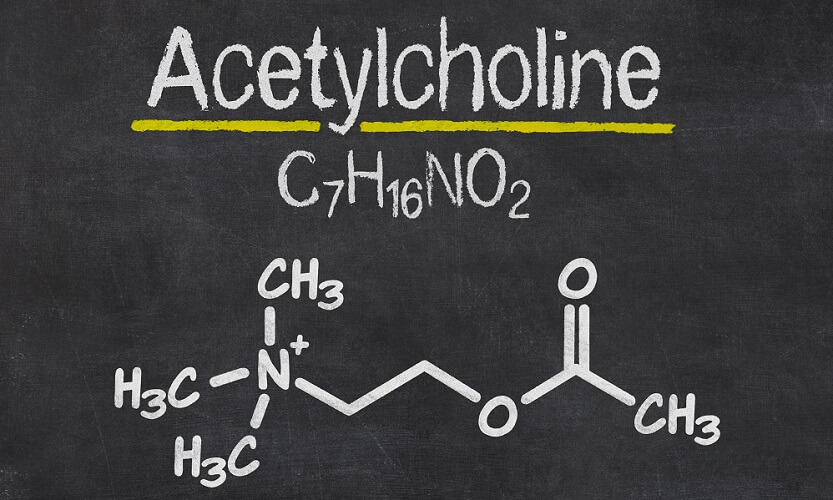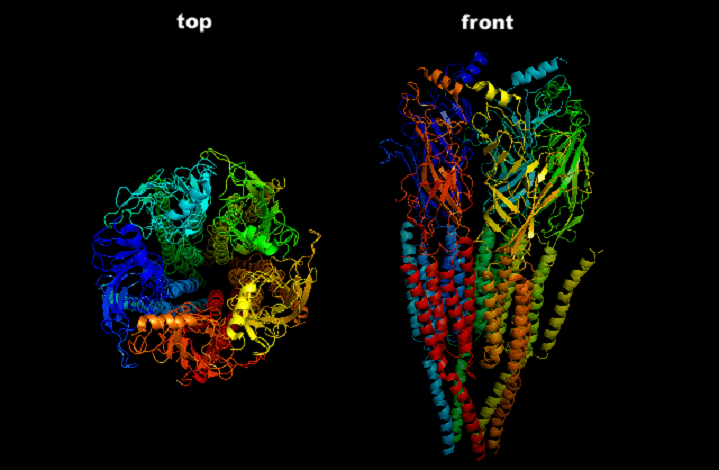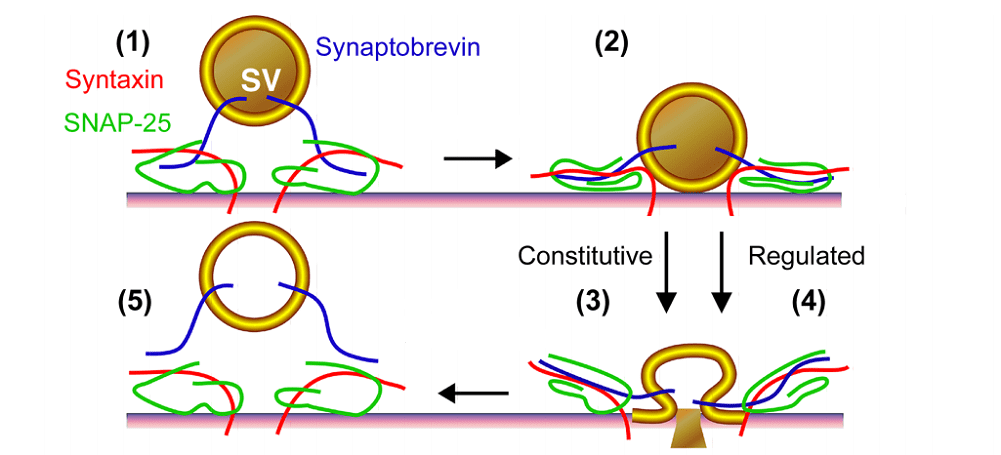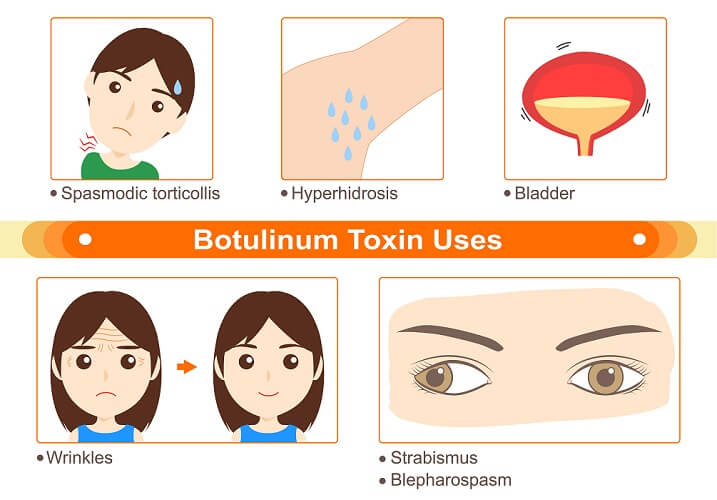Definition
Botulinum toxin, sometimes referred to as miracle poison or Botox, is the most poisonous neurotoxin. It blocks the neurotransmitter acetylcholine causing muscle paralysis. This neurotoxin is primarily produced by Clostridium botulinum bacteria and has multiple uses in the medical and cosmetic sectors. Most of us know botulinum toxin in the form of Botox injections, used in an extremely diluted form to combat the signs of aging.
Botulinum Toxin Types
Botulinum toxin types are all excreted as exotoxins by the Clostridium genus. Most are produced by C. botulinum, but some other species such as C. baratii, and C. butyricum also excrete it.
You will find Clostridium spores in the home, in food, and the soil. These spores, upon reaching a low-oxygen environment, germinate to produce bacteria.

This toxin is nothing new; the sickness known as botulism was first described as a known illness in eighteenth century Germany (but called sausage poisoning). In medieval times, some city regulations banned this type of meat, probably due to botulinum poisoning cases.
Only in 1895 was a link made between Clostridium and food-borne botulism. A professor of bacteriology at the University of Ghent, Belgium, made the connection and named the strain of bacteria botulinum, after the Latin word for sausage.

Most sources list eight types (serotypes) of botulinum neurotoxin (BoNT):
- Botulinum toxin type A
- Botulinum toxin type B
- Botulinum toxin type C
- Botulinum toxin type D
- Botulinum toxin type E
- Botulinum toxin type F
- Botulinum toxin type G
New serotypes are being discovered such as BoNT/FA, BoNT/en, BoNT/Wo, and BoNT/X. BoNT/FA used to be called botulinum toxin type H
All of these neurotoxins are extremely related and work in approximately the same way – blocking neurotransmitter release from nerve cell synapses. However, each type affects different proteins, as we will see in the next section.

Botulinum Toxin Mechanism of Action
Botulism toxin mechanism of action used to be said to only affect motor nerves. Yet Botox injections are also successfully used to treat neuropathic pain. Further research shows that this toxin also inhibits neurotransmitter release in sensory nerves.
Another discovery that has recently come to light is that Botox can pass through the blood-brain barrier, albeit in small amounts. A small study on women who received unregulated doses of Botox from non-registered cosmetic clinics showed that this toxin can access the limbic system of the brain.

To understand BoNT mechanism of action, we first have to look at the neurotransmitter acetylcholine and the nerve synapse.
Acetylcholine
Acetylcholine (ACh) is the main neurotransmitter of the (autonomic) parasympathetic nervous system and of (somatic) motor nerves that connect to skeletal muscle. It is also found in some sympathetic nerves, causing us to produce sweat and secrete adrenaline, and some interneurons of the central nervous system, including the limbic system.

First, acetylcholine must be produced. It is synthesized from choline and acetyl-CoA and requires calcium ions and an enzyme called choline acetyltransferase (CAT) to convert these two ingredients into ACh. Most of the final product is stored in vesicles at the nerve ending.
Nerve Synapse
To pass from one nerve to the next, or from a nerve to another cell (like a muscle fiber or sweat gland cell), ACh must cross a gap – the synapse. When acetylcholine is the acting messenger chemical, this synapse is called a cholinergic synapse.
Vesicles containing ACh must move to the outer membrane of the nerve terminal. Once there, they fuse with the membrane and empty their contents into the gap (the cholinergic synapse). Acetylcholine moves through this gap and arrives at the opposite side where it can stimulate a response from the next cell.
To release ACh, a nerve cell needs calcium ions and a special chain of transport proteins called a SNARE complex. The SNARE complex helps the vesicle to fuse with the membrane. It is at this point that all botulinum toxin types interfere.

On the other side of the synapse lies the target cell membrane. To be affected by the released acetylcholine, these target cell membranes need ACh receptors.
There are two types of receptor – nicotinic and muscarinic. Most muscle (except cardiac and some smooth muscle) cells have nicotinic receptors.
If acetylcholine binds with a muscarinic receptor, it excites the target cell. Muscles contract and sweat glands are stimulated – this effect is rapid and short-working.
However, the binding of ACh to nicotinic receptors produces relatively long-term inhibitory or excitatory effects.

Once the acetylcholine has passed on the message it is broken down by an enzyme called acetylcholinesterase. If you would like a more detailed look at acetylcholine mechanism of action, have a look at this page.
BoNTs and SNAREs
If someone receives a botulinum toxin injection, the toxic proteins bind to molecules found only on cholinergic nerve terminals and enter the cell.
Once there, they bind tightly to one or more of the proteins of the SNARE complex. This stops (inhibits) acetylcholine from crossing the cholinergic synapse and reaching the target cell.
In the below image, you can see how synaptobrevin connects to the round vesicle, guiding it towards the terminal membrane. Syntaxin and SNAP-25 proteins help the membranes to fuse and so allow the contents to escape from the neuron.

Synaptobrevin is a vesicle-associated SNARE protein (v-SNARE). Target cell-associated SNARE proteins are syntaxin and SNAP-25; these are t-SNAREs. All three provide the necessary energy to drive membrane fusion.
Botulinum toxin type A and type E (BoNT/A and BoNT/E) block SNAP-25 action. These toxins affect different parts of the SNAP-25 structure.
Botulinum toxin types B, D, F, and G affect the action of synaptobrevin at different points.
BoNT/C acts upon both SNAP-25 and syntaxin.
Another difference in botulinum toxin types is their form. Most are composed of two single amino acid chains (di-chains). Only BoNT/E is a single-chain toxin; it happens to be the most deadly – around one hundred times more poisonous than di-chain structures.
Botox will continue to act for anywhere up to three months.
Botox vs Black Widow Spider Poisoning

While botulinum toxin prevents acetylcholine from crossing the synapse, black widow spider poison has the opposite effect – these toxins produce opposite effects. More serious black widow spider (sp. Latrodectus) bites cause a range of symptoms grouped together under the term latrodectism.
The spider toxin allows more calcium ions into the neuron terminal and this causes all kinds of neurotransmitters to flow across the synapse. Symptoms of latrodectism include severe sweating (excitation of the sweat glands), rapid pulse (excitation of the adrenal glands), muscle stiffness, and pain (excitation/contraction of the muscles).
Botulinum toxin effects are the opposite. Stopping ACh transmission to the target cell means the absence of sweating (inhibition of the sweat glands), slow pulse (inhibition of the adrenal glands), and softer muscle tone (inhibition/relaxation of the muscles).
Botulinum Toxin Uses
Botulinum toxin uses are intrinsic to cholinergic pathways. Most treatments are used to relax skeletal muscle.

Chronic blepharospasm (twitching of the eyelids), torticollis (painful neck muscle spasms), and chronic back pain caused by muscular defects can all be successfully treated with botulinum toxin injections into the affected muscle (group).
Some types of urinary incontinence caused by smooth muscle spasms (urgency incontinence and the overactive bladder) can help to control urine loss when the cause is linked to neurological causes.
People who suffer from hyperhidrosis or excessive sweating can be given up to six month’s relief with a single botox injection.

However, by far the most popular and common botulinum toxin uses are within the cosmetic sector. Not all wrinkles can be softened with Botox, only dynamic wrinkles. Dynamic wrinkles occur when muscles directly attached to the skin contract to form lines. These lines are usually between the eyes, on the forehead, on the outer edges of the eyes, and under the eyes. Botulinum toxin injections will not remove wrinkle folds caused by sagging skin.
Both medical and cosmetic Botox injections last for between three and six months. After two to three months, the effects start to fade.
Botulinum toxin prices vary according to the manufacturer and supplier; doctors can expect to pay up to $1200 per 100 units. An open bottle cannot be stored – one of the reasons ‘Botox parties’ are popular (for both economic and social reasons).
Only a medical professional may inject botulinum toxin; pricing also needs to cover the doctor’s time and skill.

Botulinum Toxin Side Effects
There are many botulinum side effects and these effects do not always have to do with the dose. People suffering from neurological disorders may respond differently to those that do not, as do people with muscle disorders. Age can also change the effects of Botox treatment.
Short-term and less serious effects are most commonly hematoma of the injection site, pain at the injection site, headache, drooping eyelid (ptosis), double vision (diplopia), and hyperactivity of the nearest antagonist muscle. If Botox is injected into a muscle and its antagonist is left untreated, muscle contraction can still occur but in the opposite direction.

Serious effects due to injection into the bloodstream or the toxin’s spread include a dry mouth, gastrointestinal disorders, difficulty swallowing, slurred speech, a hoarse voice, and even trouble breathing.
Such symptoms will remind anesthesiologists of the effects of curare, the drug used to relax the airways and allow the said doctor to place a breathing tube between the patient’s vocal cords.
However, the standardized and permitted doses used for cosmetic and medical procedures are not enough to stop someone from breathing. The symptoms listed above are commonly reported with Botox overdose – cosmetic doses should never exceed 44 units; therapeutic doses can reach 700 units (for much larger muscles).
No deaths due to cosmetic Botox injections have been reported, although some activist groups such as Public Citizen believe up to sixteen people have died from the effects of Botox use.
A genuine botulinum toxin allergy was reported for the first time in 2014; this patient only experienced severe itching.


